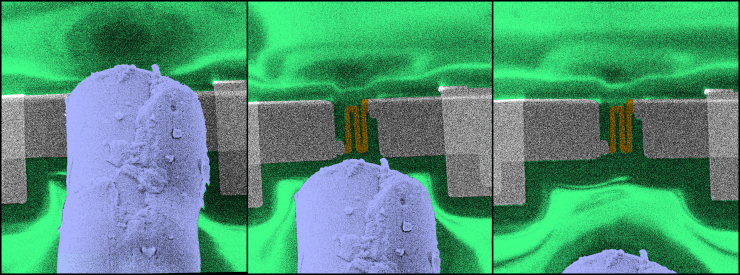Jul 3 2019
Scientists have significantly quickened the fabrication of nanoscale structures by energizing precursor molecules using a minute, high-energy supersonic jet of inert gas.
 Colorized scanning electron microscope image shows the position of a resistive thermal device RTD (nanoscale thermometer) as the deposition substrate moves relative to the micro-size nozzle capillary for gas jet injection for mapping local temperature. The RTD thermal response was used for validation of the model prediction of the adatom non-equilibrium thermal state. (Credit: Matthew R. Henry)
Colorized scanning electron microscope image shows the position of a resistive thermal device RTD (nanoscale thermometer) as the deposition substrate moves relative to the micro-size nozzle capillary for gas jet injection for mapping local temperature. The RTD thermal response was used for validation of the model prediction of the adatom non-equilibrium thermal state. (Credit: Matthew R. Henry)
The fast additive manufacturing method also allows them to create structures having high aspect ratios. A theory currently developed to illustrate the method could lead to new nanometer scale materials and new applications for additive nano-manufacturing.
The method, based on focused electron beam deposition, allows structures to be made from gas-phase precursors at rates close to what could be anticipated in the liquid phase – all without increasing the temperature of substrates. That could result in manufacturing of the nanometer-scale structures at rates that could render them useful for use in high-frequency antennas, magnetic memory, spintronics, quantum communication devices, and atomic-scale resonators.
We are controlling matter on the atomic scale to bring about new modes of additive manufacturing. This new science could bring about additive manufacturing applications that might otherwise be impossible. The resulting new technology will open up new dimensions for additive manufacturing at the atomic scale.
Andrei Fedorov, Professor in the George W. Woodruff School of Mechanical Engineering, Georgia Institute of Technology
The research grew out of frustration while attempting to produce small structures using the electron beams, which can be just a few nanometers in diameter. The study was supported by the U.S. Department of Energy’s Office of Science, and was reported in the May 28th issue of the journal Physical Chemistry Chemical Physics.
“When we went to the lab to use nanofabrication with focused electron beams, which are the size of a few nanometers, we could not grow structures that were just a few nanometers. They grew to be 50 or 100 nanometers,” Fedorov explained. “And it also took a long time to produce the structures, which meant that, without improvements, we’d never be able to produce them at high volume.”
Fedorov and collaborators Matthew Henry and Songkil Kim understood the reactions creating the structures were slow, and connected to the thermodynamic state of the substrate on which they are being grown. They then decided to introduce some energy to the process to quicken things – almost a hundred times faster.
The outcome was the invention of a micro-capillary injector measuring just a few micrometers in diameter that could introduce tiny jets of gaseous molecules into the deposition chamber to trigger the precursors for the nanoscale structures. Partially because the jet is going into a vacuum chamber, the gas speeds up to supersonic speeds. Energy from the supersonic jet excites the precursor molecules that are adsorbed to the substrate.
“This energetic thermal state allows the electrons from the beam to much more easily break chemical bonds, and as a result, structures grow much faster,” Fedorov said. “All of this amplification, both the molecule transport and the rate of reaction, are exponential, meaning a small change can lead to a dramatic increase in outcome.”
That much has been seen via experiments, but to comprehend how to regulate the process and expand its applications, the scientists wanted to develop a theory for what they were observing. They used nanoscale thermometric techniques to compute the temperature of the adsorbed atoms – also called adatoms – exposed to the jet, and used that information to help comprehend the fundamental physics at play.
“Once we have a model, it essentially becomes a design tool,” Fedorov said. “With this understanding and the capabilities we have demonstrated, we can expand them to other fields such as directed self-assembly, epitaxial growth, and other areas. This could enable a whole host of new capabilities to use this kind of direct-write nanofabrication.”
Development of the model and comprehending the first-principles physics underlying it could also allow other scientists to identify new applications.
With this, you can have almost the same order of magnitude growth rate as you’d have with liquid phase precursors, but still have access to the richness of possible precursors, the ability to manipulate alloying, and all the experience that has been developed over the years with gas phase deposition. This technology will allow us to do things at a scale that is meaningful from a practical standpoint and cost-effective.
Andrei Fedorov, Professor in the George W. Woodruff School of Mechanical Engineering, Georgia Institute of Technology
The ability to quickly make small, 3D structures could pave the way for a variety of new applications.
“If you can adapt additive direct-write techniques, this could bring a lot of unique capabilities for magnetic memory, superconducting materials, quantum devices, 3D electronic circuitry, and many more things,” he said. “These structures are currently very hard to make using conventional methods.”
Beyond using the jets to speed up the deposition of precursor materials already on the substrate, the scientists have also developed hybrid jets that consist of both precursor gases and high-energy inert gas, which allow not only a significant acceleration of nanostructure growth but also precise control of the material composition during growth. In future research, the scientists aim to use these hybrid methods to facilitate the formation of nanostructures with phase and topology that cannot be realized by any current nanofabrication methods.
This study received support from the U.S. Department of Energy (DOE), Office of Science, Basic Energy Sciences (BES), under Award #DE-SC0010729.